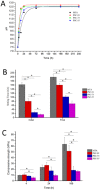Effect of tricalcium aluminate on the physicochemical properties, bioactivity, and biocompatibility of partially stabilized cements
- PMID: 25247808
- PMCID: PMC4172564
- DOI: 10.1371/journal.pone.0106754
Effect of tricalcium aluminate on the physicochemical properties, bioactivity, and biocompatibility of partially stabilized cements
Abstract
Background/purpose: Mineral Trioxide Aggregate (MTA) was widely used as a root-end filling material and for vital pulp therapy. A significant disadvantage to MTA is the prolonged setting time has limited the application in endodontic treatments. This study examined the physicochemical properties and biological performance of novel partially stabilized cements (PSCs) prepared to address some of the drawbacks of MTA, without causing any change in biological properties. PSC has a great potential as the vital pulp therapy material in dentistry.
Methods: This study examined three experimental groups consisting of samples that were fabricated using sol-gel processes in C3S/C3A molar ratios of 9/1, 7/3, and 5/5 (denoted as PSC-91, PSC-73, and PSC-55, respectively). The comparison group consisted of MTA samples. The setting times, pH variation, compressive strength, morphology, and phase composition of hydration products and ex vivo bioactivity were evaluated. Moreover, biocompatibility was assessed by using lactate dehydrogenase to determine the cytotoxicity and a cell proliferation (WST-1) assay kit to determine cell viability. Mineralization was evaluated using Alizarin Red S staining.
Results: Crystalline phases, which were determined using X-ray diffraction analysis, confirmed that the C3A contents of the material powder differed. The initial setting times of PSC-73 and PSC-55 ranged between 15 and 25 min; these values are significantly (p<0.05, ANOVA and post-hoc test) lower than those obtained for MTA (165 min) and PSC-91 (80.5 min). All of the PSCs exhibited ex vivo bioactivity when immersed in simulated body fluid. The biocompatibility results for all of the tested cements were as favorable as those of the negative control, except for PSC-55, which exhibited mild cytotoxicity.
Conclusion: PSC-91 is a favorable material for vital pulp therapy because it exhibits optimal compressive strength, a short setting time, and high biocompatibility and bioactivity.
Conflict of interest statement
Figures


 C3S;
C3S;  Bi2O3; ▪ Ca(OH)2; ▴ CSH; • C3AH6].
Bi2O3; ▪ Ca(OH)2; ▴ CSH; • C3AH6].



References
-
- Schmalz G, Smith AJ (2014) Pulp development, repair, and regeneration: challenges of the transition from traditional dentistry to biologically based therapies. J Endod 40: S2–5. - PubMed
-
- Witherspoon DE (2008) Vital pulp therapy with new materials: new directions and treatment perspectives–permanent teeth. J Endod 34: S25–28. - PubMed
-
- Ho YC, Huang FM, Chang YC (2006) Mechanisms of cytotoxicity of eugenol in human osteoblastic cells in vitro. Int Endod J 39: 389–393. - PubMed
Publication types
MeSH terms
Substances
LinkOut - more resources
Full Text Sources
Other Literature Sources

